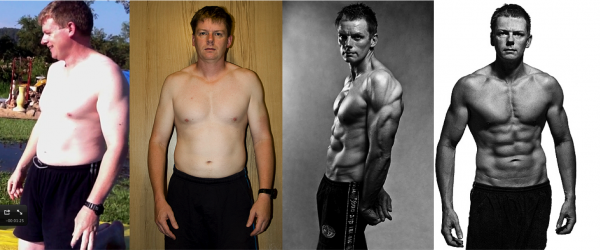Here’s your new interview with one of the winners from the 8th Adonis Index Transformation Contest.
Today John talks to Simon Bernard who won 1st place in the 12-Week Transformation.
Check out his transformation pictures:

Simon’s results after 12 weeks of the contest.
Simon has entered a couple of our contests but never achieved his desired results. He stands at 5’7” and was about 145 pounds before finding the Adonis Index; today he weighs 127 pounds.
For this particular contest, he change his approach slightly. What he decided to do differently was what Adonis Index preaches all the time – lose fat first, build muscle afterwards (or in the process).
Here’s his whole Adonis transformation:

Simon’s overall progress with Adonis Index.
Simon shared with us that while growing up he was always referred to as “the chubby kid”.
He had this idea of losing fat first and then building muscle already in his head in the past, but once he got involved in the fitness community his thinking became skewed. He was lead to believe that he should focus on getting bigger and bulking up. The industry convinced him that “mass & bulking” is the goal he should aim for and that excess energy will simply be converted into muscle tissue.
However, it really makes sense to get lean first and go from there. You can lose fat pretty quickly, it’s building muscle that takes some time. And since you can’t really eat your way up to bigger muscles, it doesn’t make sense to get fat in the process of attempting to “put on” more muscle.
Another thing most people don’t realize is that you can actually do both!
You can build muscle while being in a caloric deficit. It won’t be that much and you won’t impress any bodybuilder with it, but if your training is good, then you can do it.
And since your energy levels and calorie intake will get better once you get lean you don’t really have to worry about the speed of building the muscles.
Focus on what you want, don’t let the fitness industry dictate your goals.
“Getting in Shape is Complicated and You Will Suffer in the Process”…Oh Really?!?
When it comes to mainstream media, people often lose touch with reality which results in the disbelief that getting in shape could be simple.
According to most fitness “experts” fat loss revolves around hormones, pills, special foods and supplements…it couldn’t possibly be about calories; a concept so simple even an eight year old could figure it out.
People try to overcomplicate things, look for excuses and then wonder how they never manage to get in shape.
Simon did several 24 hour fasts during the 12 week contest period, he ate almost anything he wanted and never skipped weekend social eating events full of drinking, eating at restaurants and snacking on “unhealthy food”.
During the week he ate a little less to prepare for the weekend in order to remain in the “fat burning zone”.
During the day he ate two meals – his first being breakfast and second, a late night dinner.
He kept it simple.
He didn’t even count calories; simply guessing how much he ate.
Many will wonder how someone like Simon comes along and makes a stunning transformation while eating pretty much whatever he wanted. It appears magical when it’s actually just how your body works.
Once you understand the process, it’s just about finding a way to make it happen for you within your own lifestyle.
Tips from Simon:
- Keep it simple
- Be consistent
- Follow the program as it is written, don’t change stuff
- Don’t involve too many people in the process (when you talk to people even if you are explaining things in the right way, most tend to be jealous and will question to your methods despite the fact that you may look better than them already)
- Prepare for your social eating events in advance (you can use intermittent fasting for example)
- Nobody has 12 weeks of perfection, you will have your ups and downs during your journey/contest
- I have two different jobs and still managed to have time to got to the gym almost every day, it’s more about your mindset and not the “in-depth” mechanics of your lifestyle
Links from the interview:
- Main Adonis Index Workout 3.1 – The workout that’s responsible for the most amazing transformations online
- Muscle Building Foundation – Build your muscle mass foundation in the next 12 weeks
- Booster Specializations – Bring up your lagging body parts
Read Simon’s experience with Adonis Index in his own words:
When I think about it, I’ve always wanted to have a great looking body. As a kid, it was probably more to resemble my favorite actors, like Shwartzenegger, or Van Damme… Later, I just understood all the benefits (health and social status) related to looking good. The only problem was I spent too much time philosophing and playing music rather than playing sports and ended up rather chubby. I tried many different approaches and…Continue reading here
Listen to the interview here, and please “like” it when you’re done:
Podcast: Play in new window | Download












